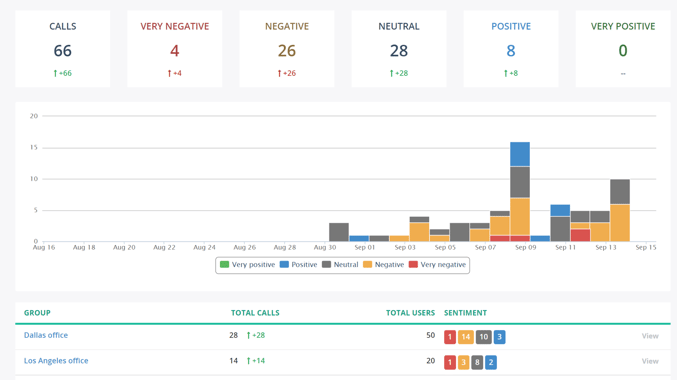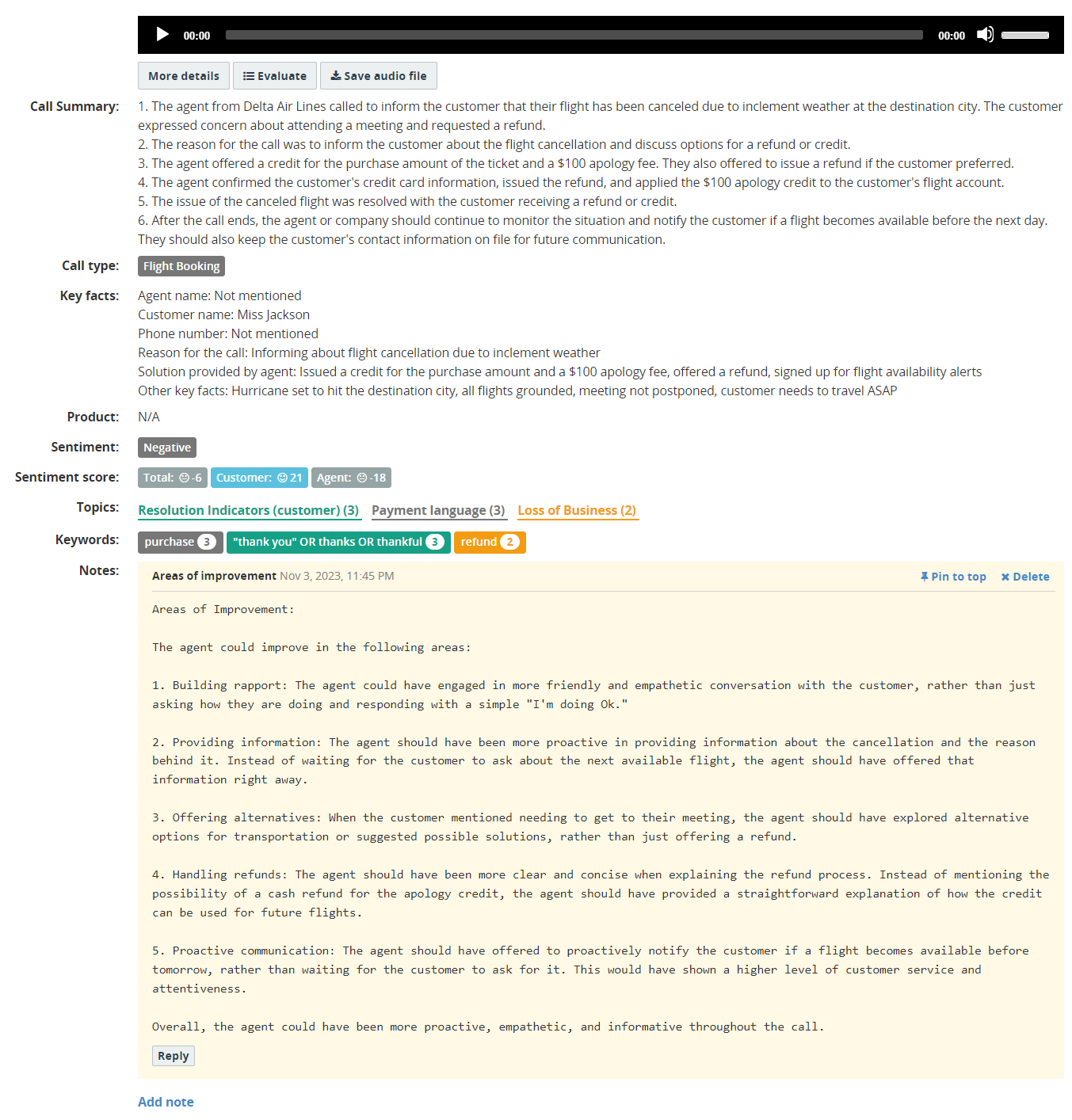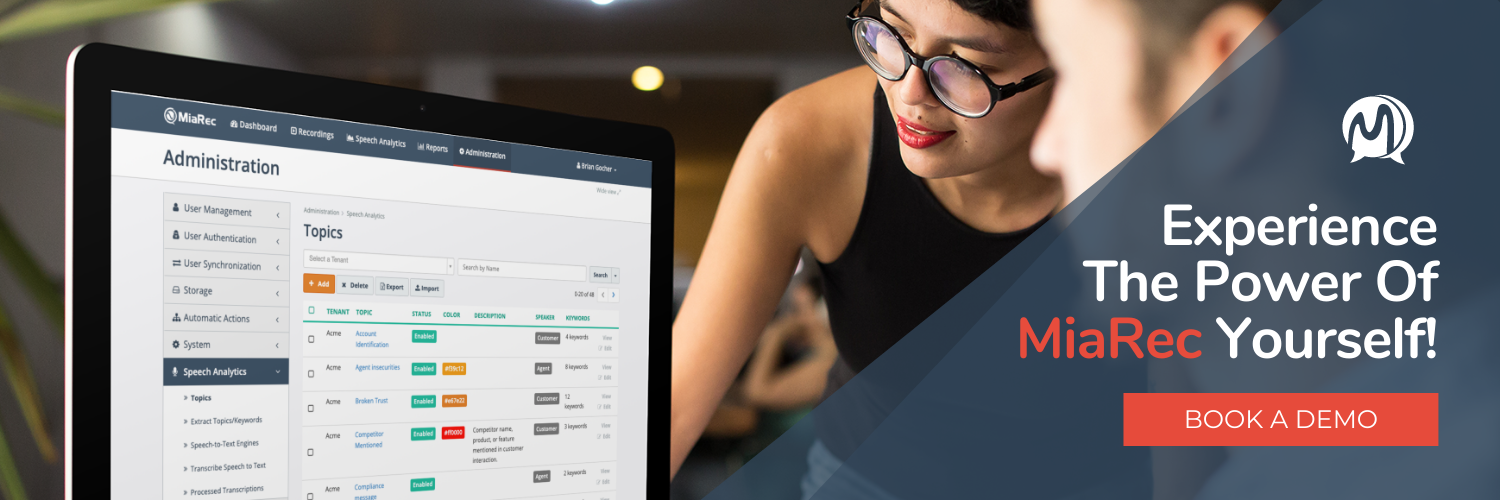Real-Time vs Post-Call Analytics: Benefits, Use Cases, & Differences
Contact centers are at the forefront of customer interactions, making data analysis an essential part of improving customer service, agent performance, and overall efficiency. Two primary approaches to data analytics in contact centers are real-time analytics and post-call analytics. Each approach has its own set of benefits, use cases, and key differences.
At MiaRec, we've empowered numerous contact centers to unlock the full potential of their voice data. Our Voice Analytics solutions enable contact centers to streamline quality and compliance processes, gain valuable customer insights through tools like Sentiment and Topical Analysis, implement Automated Quality Management, leverage AI assistance, and more.
In this blog post, we'll explore the world of real-time and post-call analytics, providing examples and insights to help you understand when and how to leverage each for your contact center operations.

Topics Covered In This Article:
- Understanding Real-Time Analytics
- Post-Call Analytics: A Deeper Dive
- Key Differences Between Real-Time and Post-Call Analytics
- When to Use Real-Time Analytics
- When to Use Post-Call Analytics
Understanding Real-Time Analytics
Real-time analytics in contact centers have revolutionized the way businesses manage their customer interactions. With the ability to analyze data as it's generated during customer-agent conversations, contact centers can now gain valuable insights and make informed decisions in real-time. This real-time analysis enables businesses to provide quick responses to customer needs, enhance agent performance, and ensure compliance with regulatory requirements.
By leveraging real-time analytics, contact centers can effectively monitor and evaluate customer-agent interactions as they happen. This allows them to identify any issues or areas for improvement immediately, enabling them to take proactive measures to address customer concerns and optimize agent performance. With the ability to make data-driven decisions in real-time, businesses can enhance their customer service delivery and ultimately improve customer satisfaction.
Moreover, real-time analytics also play a crucial role in ensuring compliance with industry regulations and internal policies. By analyzing data in real-time, contact centers can identify any potential compliance breaches or deviations from established protocols. This allows them to take prompt action to rectify any issues and ensure that all customer interactions adhere to the required standards.
The benefits of real-time analytics in contact centers are undeniable. By gaining valuable insights and making data-driven decisions in real-time, businesses can effectively meet customer needs, enhance agent performance, and ensure compliance. With the ever-increasing demand for exceptional customer service, real-time analytics have become an essential tool for contact centers looking to stay ahead in today's competitive business landscape.
Benefits of Real-Time Analytics
-
Instant Issue Resolution: Identify and address customer issues as they arise, leading to higher customer satisfaction.
-
Enhanced Agent Performance: Provide agents with real-time feedback and coaching for better interactions.
-
Fraud Detection: Detect and prevent fraudulent activities during live interactions.
Use Cases of Real-Time Analytics
-
Call Routing: Using real-time data to route calls to the most appropriate agents based on skill, availability, and historical performance.
-
Cross-Selling and Up-Selling: Identifying opportunities for cross-selling or up-selling during a call and providing agents with real-time recommendations
-
Real-Time Agent Assistance: Empowering agents with real-time on-screen cues and recommendations tailored to customer inquiries during live calls.
Post-Call Analytics: A Deeper Dive
Post-call analytics involve the analysis of data after a customer-agent interaction has concluded. This crucial process allows businesses to delve deeper into the details of each conversation, uncover valuable insights, and identify areas for improvement. By examining historical data, businesses can gain a comprehensive understanding of their performance, measure key metrics, and make data-driven decisions to enhance customer experiences.
With post-call analytics, organizations can unlock a wealth of information that goes beyond the surface-level conversation. By analyzing various data points, such as call duration, customer sentiment, agent performance, and customer satisfaction ratings, businesses can identify patterns, trends, and areas of strength or weakness. These insights enable them to refine their strategies, optimize their processes, and deliver exceptional customer service consistently.

Screenshot of the MiaRec Agent Evaluation report, featuring sentiment scores, topics and keyword mentioned, total evaluation score, and more.
Moreover, post-call analytics help businesses track their performance over time and set benchmarks for improvement. By comparing results from different time periods, organizations can determine whether their efforts are yielding positive results or if adjustments need to be made. This data-driven approach empowers businesses to make informed decisions, allocate resources effectively, and implement targeted training programs to enhance agent performance.

Screenshot of the MiaRec Sentiment Analysis dashboard.
Post-call analytics is also crucial for businesses to ensure compliance with industry regulations and standards. It offers various solutions, such as Automated Quality Management, that enable contact centers to score 100% of the calls and ensure script adherence. This helps organizations maintain consistency in their customer interactions and meet regulatory requirements.
Additionally, post-call analytics provides a solution called Auto Data Redaction, which automatically removes sensitive information from call transcripts. This ensures that customer data is protected and minimizes the risk of data breaches. By implementing this solution, businesses can enhance their data security measures and maintain customer trust.

Screenshot of the MiaRec ML-based Auto Data Redaction functionality.
Overall, post-call analytics not only allows organizations to gain valuable insights and improve their performance but also helps them meet compliance requirements and protect customer data. By leveraging these solutions, businesses can ensure that their contact center operations are in line with industry standards and regulations, ultimately enhancing customer experiences and maintaining a secure environment.
In addition, post-call analytics provide businesses with a comprehensive overview of customer-agent interactions, enabling them to identify successful strategies and replicate them across the organization. By analyzing successful calls, businesses can uncover best practices, identify effective communication techniques, and share these insights with their teams. This facilitates knowledge sharing, improves consistency in customer interactions, and ultimately leads to higher customer satisfaction rates.
Although one of the key benefits of real-time analytics is its ability to provide immediate assistance to agents, post-call analytics also offers a wide range of innovative solutions to assist agents and automate their workflows. One such solution is the introduction of Auto Call Summaries, a feature designed to eliminate the need for agents to spend valuable time on tedious note-taking tasks.
Auto Call Summaries eliminate the need for manual note-taking, allowing agents to fully focus on the customer and provide personalized service. It also enables agents to quickly review previous interactions, tailoring their approach based on customer history. Contact center supervisors and managers can gain insights from these summaries to enhance agent performance and the overall customer experience. Auto Call Summaries streamline workflow and boost efficiency during customer interactions, contributing to outstanding customer experiences.

Screenshot of the MiaRec Generative AI-based Auto Call Summary functionality offering a full structured call summary, call type, key facts about the call, both agents' and customer sentiment score, topics, and automatically generated areas of improvement (Agent feedback).
Post-call analytics is a powerful tool that empowers businesses to gain valuable insights, measure performance, and drive continuous improvement. By leveraging historical data, organizations can elevate their customer experiences, optimize operations, and maintain a competitive edge in today's dynamic business landscape.
Benefits of Post-Call Analytics:
-
Comprehensive Performance Analysis: Evaluate agent interactions and customer experiences in detail.
-
Automation of Quality Management and Compliance processes: Monitor 100% of the calls with AI to ensure that interactions adhere to industry regulations and quality standards.
-
Customer Sentiment Monitoring: Gauge customer sentiment and adjust your CX strategy accordingly.
-
Long-Term Strategy: Use historical data to inform long-term planning and decision-making.
Use Cases and Examples:
-
Automated Quality Assurance: Automatically scoring 100% of the calls with Automated Quality Management and automate your QA processes
-
Agent Training: Using historical data to identify coaching opportunities and develop agent training programs.
-
Compliance Reporting: Ensuring all interactions comply with industry regulations, such as script adherence.
-
Automated Data Redaction: Automatically redacting sensitive data using AI and machine learning.
-
Customer Insights: Analyzing trends and patterns in post-call data to inform product development or marketing strategies.
Key Differences Between Real-Time and Post-Call Analytics
Real-time analytics focus on immediate data analysis during live interactions, while post-call analytics review historical data after interactions have ended. Real-time analytics allow organizations to capture data in the moment, allowing them to make instant decisions and take immediate action based on customer interactions. This means that agents can receive real-time assistance during live calls, enabling them to identify cross-selling or up-selling opportunities and provide personalized recommendations to customers. On the other hand, post-call analytics offer a more comprehensive view of performance over time. By analyzing historical data, businesses can gain insights into patterns, trends, and areas of strength or weakness. This allows them to refine their strategies, optimize their processes, and deliver exceptional customer service consistently. Both real-time and post-call analytics play important roles in enhancing agent performance and improving the overall customer experience.
-
Data Timing: Real-time analytics focus on immediate data analysis during live interactions, while post-call analytics review historical data after interactions have ended.
-
Agent Performance vs Agent Assist: Real-time analytics are often geared toward improving agent performance during live interactions, while post-call analytics offer a more comprehensive view of performance over time.
-
Proactive vs. Reactive Insights: Real-time analytics provide proactive insights for immediate action, while post-call analytics offer reactive insights for long-term improvement.
Combining Real-Time and Post-Call Analytics
Achieving a Comprehensive View: By combining both real-time and post-call analytics, contact centers can gain a holistic view of their operations, addressing immediate issues and making long-term improvements. Real-time analytics provide valuable insights into agent performance and customer interactions as they happen, allowing supervisors to offer immediate assistance and guidance to agents during live calls. On the other hand, post-call analytics offer a more comprehensive analysis of historical data, enabling businesses to identify patterns and trends over time. By integrating these two approaches, contact centers can not only address immediate issues but also track performance trends, identify areas for improvement, and make data-driven decisions for long-term enhancements.
Creating Seamless Workflows: Integrating the two approaches allows for seamless workflows, such as automatically triggering post-call analysis for flagged interactions from real-time analytics. With real-time analytics, contact centers can monitor live interactions, identify critical moments, and flag specific calls that require further analysis. These flagged interactions can then be seamlessly transitioned into post-call analytics, where a more detailed analysis can be conducted after the call ends. This integration streamlines the process, ensuring that relevant data is automatically captured for further evaluation. By automating the transition from real-time to post-call analytics, contact centers can save time, improve efficiency, and ensure that no valuable insights are missed.
Conclusion
Real-time and post-call analytics are both integral components of an effective contact center strategy, each providing unique benefits and use cases. It is essential for organizations to recognize the value of both approaches and how they can work together to drive customer satisfaction, agent performance, and regulatory compliance.
Real-time analytics offer immediate insights into customer interactions as they happen, enabling contact centers to address issues in real-time. This allows supervisors to provide immediate assistance and guidance to agents during live calls, improving agent performance and enhancing the overall customer experience. Real-time analytics also enable contact centers to identify critical moments in customer interactions, such as cross-selling or up-selling opportunities, and provide personalized recommendations to customers. By leveraging real-time insights, contact centers can make instant decisions and take immediate action based on customer interactions, ensuring that they meet and exceed customer expectations.
On the other hand, post-call analytics provide a comprehensive analysis of historical data, allowing contact centers to gain insights into patterns, trends, and areas of strength or weakness over time. By examining data points such as call duration, customer sentiment, agent performance, and customer satisfaction ratings, businesses can identify areas for improvement and refine their strategies. Post-call analytics also enable contact centers to track their performance over time and set benchmarks for improvement. By comparing results from different time periods, organizations can determine whether their efforts are yielding positive results or if adjustments need to be made. This data-driven approach empowers businesses to make informed decisions, allocate resources effectively, and implement targeted training programs to enhance agent performance.
By combining the power of real-time insights and the depth of historical analysis, contact centers can create a well-rounded and data-driven contact center strategy. Real-time analytics provide immediate insights and assistance during live interactions, while post-call analytics offer a deeper analysis of historical data. Together, these approaches enable contact centers to address immediate issues, track performance trends, and make informed decisions to enhance customer experiences. The seamless integration of these two approaches ensures that no valuable insights are overlooked, leading to more efficient workflows and improved overall performance.
In conclusion, real-time and post-call analytics are both essential components of a successful contact center strategy. By leveraging the strengths of both approaches, contact centers can meet customer expectations, drive agent performance, and ensure regulatory compliance. It is not a matter of choosing one over the other, but rather leveraging both in a cohesive and coordinated manner to create a well-rounded and data-driven contact center strategy.
Share this
You May Also Like
These Related Stories

What To Expect When Setting Up Topic Analysis

Agent Evaluations Best Practices: The Importance of Automated Call Scoring





